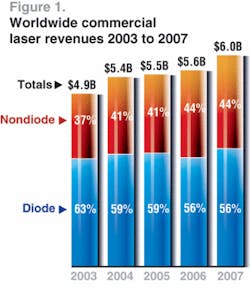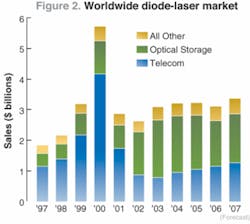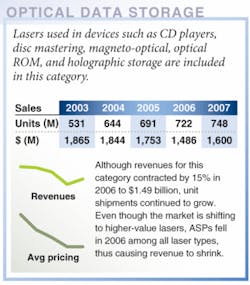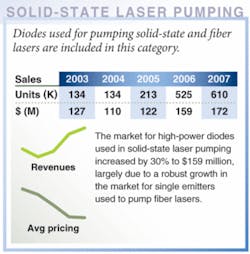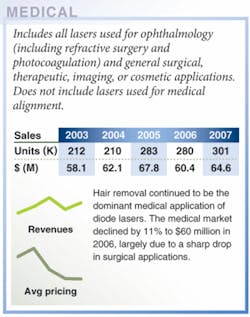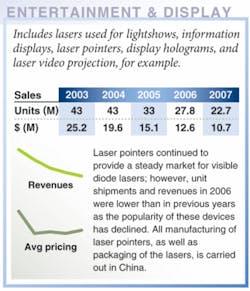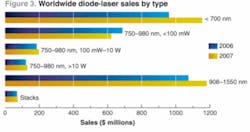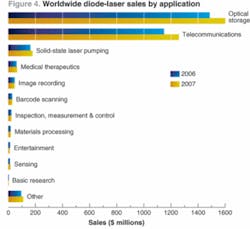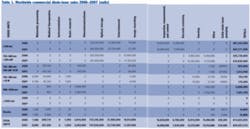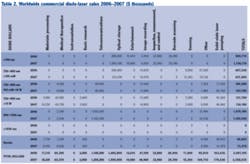ROBERT V. STEELE, STRATEGIES UNLIMITED
The Laser Focus World 2007 Annual Review and Forecast of the Laser Markets is conducted in conjunction with Strategies Unlimited of Mountain View, CA. Part II covers the diode-laser marketplace. Part I, which reported on the nondiode-laser market, appeared last month (see www.laserfocusworld.com/articles/282527).
The diode-laser market was mixed in 2006, with revenues in some categories increasing significantly, and those in other categories showing substantial declines. In particular, the revenue picture for diode lasers used in optical-storage applications exhibited a sharp downturn, mainly due to a maturing of the market and declining prices. Conversely, most other applications showed moderate growth, including telecom and high-power-diode applications. Overall, the diode-laser market declined slightly from $3.23 billion in 2005 to $3.10 billion in 2006, down 4%, accounting for 56% of worldwide laser revenues (see Fig. 1). This decline occurred after three years of steady growth following the bottoming out of the telecom market in 2002.
In contrast to the revenue situation, unit growth continued positive, with 815 million diode lasers shipped in 2006 compared to 778 million in 2005 (up 5%), indicating that market demand, especially in the high-volume consumer optical-storage applications, continued to grow, even though at a modest rate. As in past years, the yen-dollar exchange rate had an impact on the average selling prices (ASPs) for high-volume optical-storage lasers, which constituted 48% of total revenues. The value of the yen against the dollar decreased by 5% in 2006, thus lowering the dollar ASPs for optical-storage lasers and several other categories (desktop printing, barcode scanning) by the same amount. In addition, however, the yen-denominated ASP for these lasers dropped as well.
The steady diode-laser market growth from 2002 through 2005, driven in large part by recovery in the telecom market, is clearly seen in the market’s 10-year history (see Fig. 2). The impact of the revenue downturn of optical storage in 2006 is also obvious. There is optimism for recovery in 2007, with 8.4% growth predicted. For the optical-storage component of the market, growth will be driven by the increased adoption of next-generation optical-disc drives.
Optical storage
The major news for 2006 was the long-delayed introduction of the next generation of high-capacity optical-storage technology, which involves two competing formats-HD‑DVD and Blu-ray Disc. A number of major consumer electronics companies-Toshiba, Matsushita (Panasonic), Sony, Samsung, Pioneer-introduced HD-DVD and Blu-ray Disc players to the market during the year. However, sales of these players were relatively low because it was only in the latter part of the year that movie titles became available in these formats. As discussed last year (see www.laserfocusworld.com/articles/248128), all attempts at reconciling the format differences between HD-DVD technology (promoted by Toshiba) and Blu-ray Disc technology (promoted by Sony) have failed. Thus, for the foreseeable future two formats will exist in the market.
In terms of diode-laser sales, the main impact in 2006 was not video players but the next generation of video game players introduced by Sony-the PlayStation 3. This game player incorporates state-of-the-art microprocessor and graphics-rendering technology, as well as a Blu-ray Disc optical drive. Sony Consumer Electronics is counting on the PlayStation 3 to be a major revenue generator for the company in 2007 and beyond.
Sony intended to introduce the PlayStation 3 in the spring of 2006. However, after many technical and production difficulties, it did not become available in stores until November, with the first release in Japan, followed by the United States. It will not be available in Europe until late this year. One of the main production issues was availability of the 405 nm gallium nitride-based diode lasers required for the Blu-ray Disc optical drive. Following an earlier technology sharing agreement with Nichia (the original inventor of 405 nm laser technology), Sony decided to produce all lasers for its Blu-ray Disc player and PlayStation 3 internally at its Sony Shiroishi Semiconductor operation, which also produces 780 and 650 nm lasers for CD- and DVD-based drives. Because of the extreme difficulty of scaling up production to millions of units, 405 nm laser diodes were not available to meet Sony’s initial ambitious plans, but by November enough lasers were being produced to launch the PlayStation 3. Sony originally announced plans to ship 3 million units by the end of 2006, but that was later scaled back to 2 million.
For 2006, the vast majority of 405 nm diode lasers shipped was for the PlayStation 3. Revenues from these shipments augmented the revenues from the 780 and 650 nm lasers for the older generation of CD and DVD drives. For these lasers, unit shipments continue to increase during 2006-from 691 million to 720 million-but continuing erosion of ASPs resulted in revenues falling by 21% to $1.46 billion. Revenues from the sale of 405 nm lasers were just $26 million, not enough to offset the revenue decline for 780 and 650 nm lasers.
Clearly, the market for CD- and DVD-based optical-storage products is mature, and future unit growth rates for lasers will be low, accompanied by flat to falling revenues depending on whether ASPs stabilize or keep going down. HD-DVD and Blu-ray Disc represent the future of the optical storage market, and consumer-electronics companies such as Sony and Toshiba are investing heavily on the future growth of these new technologies. For 2007, revenues of $155 million are forecast for 405 nm lasers, and this will constitute the sole source of growth for the optical-storage laser market, which is forecast at $1.60 billion.
Telecommunications
The telecom industry continues to grow steadily, with about 8% to 12% revenue growth in the optical-components sector. The growth is occurring in every segment: long-haul, metro, and access. Dense-WDM system growth has been especially strong after several years of underutilization of the installed systems. Growth in metro networks is particularly interesting with regard to reconfigurable networks. Carriers are finally looking to these new systems to make their networks more flexible. And, fiber-to-the-home (FTTH) systems are being installed at a rapid pace, although the number of homes actually connected remains relatively small in the U.S.
What this means for lasers is steady growth in unit sales-from 4.385 million in 2005 to 4.81 million in 2006 (up 10%)-as well as revenues, with unit growth outpacing ASP declines. While unit growth remains strong, prices for individual product types continue to fall up to about 10% per year, although the mix changes, slowing the decline in average price for the whole group by 5% or less. Tunable lasers are finally seeing rapid growth, to save on the number of wavelengths that must be kept in inventory to support DWDM systems. Leaders are JDS Uniphase’s Agility operation, Intel, and Santur.
Even with all of this unit growth, and even decent revenue growth, several large component suppliers were still losing money in 2006. In fact, nearly every diode-laser supplier with its own chip fabrication facilities was either losing money, or finally showing a modest profit after several years of losses. Two examples are Avanex and Bookham. There are some exceptions, particularly among smaller manufacturers, but, more important, the companies that did not have fabs seem to find it far easier to make a profit.
For several years the industry has been anticipating consolidation of larger players to eliminate some of the excess manufacturing capacity and thereby increase the utilization of capacity. Toward the end of 2006, rumors began circulating about the possible merger of Avanex and Bookham in such a scenario. If this proceeds as envisioned, it could improve profitability of the sector. But it is never easy, however it is done.
All of this is only relevant to transmission lasers. For fiber-amplifier pump lasers, the industry has already settled on just a few key suppliers: Bookham and JDS Uniphase in 980 nm pumps, and Furukawa Electric in 1480 nm and 14xx nm pumps. The average output power for pumps continues to climb. With steady or slightly declining unit prices, the price per watt therefore continues to decline. 2006 was another great year for optical amplifiers and the pumps that go into them. Unit sales and revenues were at record levels for recent years.
It is difficult to see what 2007 will bring for pump lasers, however. Visibility is notoriously short in this part of the business. The normal cycle would be for another year or two of strong sales, followed perhaps by some softening before another cycle. The surprisingly strong sales in 2005 and 2006, however, may mean that the industry is already at a peak. Or alternatively, strong growth in traffic has finally forced the telecom carriers to install more infrastructure-a development that may continue for several years. The forecast is that 2007 will be like 2006, but it will be important to watch the purchasing patterns of the carriers carefully as the year proceeds.
High-power diode lasers
The market for high-power diode lasers exhibited unit and revenue growth during 2006, continuing a trend that has been ongoing for several years. The term “high-power” encompasses three laser types: single emitters (>100 mW), bars (>10 W) and stacks, all in the 750-980 nm wavelength range (but excluding 980 nm pump lasers for fiber amplifiers). Revenue grew by 15% to $286 million in 2006, and units grew by 52% to 951,500. The major growth story in high-power lasers was pumps for fiber lasers. These typically are higher power (5-10 W) single emitters, operating at 965 nm, used to energize the Yb-doped fiber gain medium of fiber lasers. The growth in these devices has followed the success of the fiber laser, as noted in Part I of this article last month (see www.laserfocusworld.com/articles/282527).
The leading manufacturer of fiber lasers (more than 90% market share) is IPG Photonics. The company has a captive facility to produce 965 nm single-emitter pump lasers, and production has scaled to match its spectacular market growth. This captive production was the main contributor to the market growth of single-emitter, high-power diodes in 2006, for which the total market was 490,000 units and $71.3 million representing growth of 172% and 97.5%, respectively (although it is likely that fiber-laser pumps were undercounted in 2005). Single emitters were also the largest element in the solid-state laser pumping application, accounting for 45% of the market.
Growth for the other high-power diode categories and applications continued at a generally steady, though modest, pace. The market for diode-laser bars grew by 3% to $121.7 million, while the market for stacks grew by 6% to $69.2 million. Within individual applications, materials processing grew by 20% to $17.1 million, largely due to growth in the “other” materials processing segment (that is, not metals, microelectronics, or marking), including applications such as plastics joining and epoxy curing. Commercial printing (computer to plate), also showed a modest uptick of 7.5% to $27.4 million, largely due to the increased use of bars and individually addressed bars (IABs) at press manufacturers such as Agfa, CREO, Dai Nippon Screen, Heidelberg, and Presstek. The market for single emitters in this application was relatively flat.
In contrast to the applications discussed above, the medical therapeutic market actually declined by about 11% to $60.4 million. The largest part of this market-handheld hair removal-was flat while stacks for stationary hair-removal equipment declined slightly due to a modest decline in units and ASP. The main contributor to the overall 11% drop in the market was diode bars used in surgical applications. The trend in this application has been somewhat erratic from year to year, so it is not clear whether the 2006 result represents a clear direction or just an anomaly.
Other applications
A variety of applications other than those discussed above-including local-area networks, or LANs (includes storage-area networks, or SANs); sensing; entertainment; barcode scanning; and inspection, measurement, and control-and excluding all high-power diode-laser applications, accounted for $209 million in 2006, or 7% of the diode-laser market. The largest of these applications was LANs, which use transceivers incorporating 850 nm VCSELs and 1300 nm edge-emitting lasers. This market grew by 9% in 2006, reflecting the continuing growth in the corporate IT market, of which local-area networks and storage-area networks are an integral part. This market had a dramatic decline during the high-tech market collapse of 2001-2002, and it has been gradually recovering ever since.
Most other applications showed steady but moderate growth, following long-term trends. The exception was “entertainment”-mainly laser pointers-which has been a declining market in recent years. One of the more interesting growth areas is the use of VCSELs in the computer optical-mouse application where they are gradually taking over from red LEDs, using technology developed by Agilent Technologies. Included in the “sensing” applications category, the optical-mouse market grew by 41% in revenue in 2006, to $9.9 million, even though the VCSEL ASPs decreased by a factor of two.
ROBERT V. STEELE is director of optoelectronics at Strategies Unlimited, 201 San Antonio Circle, Suite 205, Mountain View, CA 94040; [email protected]; www.strategies-u.com.
Correction
In the January Market Review and Forecast the unit and sales revenue numbers published in Table 1 and Table 2 for solid-state lamp-pumped lasers were incorrect. The correct numbers can be seen online at www.laserfocusworld.com/articles/282527.
Presenting the data
Diode-lasers sales data for 2006 and forecast for 2007 are charted in detail by application and by type in Figures 3 and 4, respectively. Diode-laser sales data by unit shipment and dollar revenues are shown in Tables 1 and 2. For an explanation of our methods, see “Where the numbers come from” on p. 74.
null
The data presented in the tables here are available with additional commentary in the Feb. 1 issue of Optoelectronics Report (see www.optoelectronicsreport.com).
Diode-laser products and configurations
The diode-laser revenue figures shown in Table 2 are based on the unit sales figures in Table 1 and average selling prices (ASPs) for each type of diode laser. Average prices for diode lasers vary widely and are a function of wavelength, power output, and package type. The revenue figures are for packaged devices as they are sold by diode-laser suppliers to the merchant market or transferred internally to other company divisions to be used in system level products. Diode-laser packaging is subject to a wide range of configurations according to the device type and application requirements, and includes variations such as thermal control and fiber coupling. Short-wavelength (<1000 nm) diode lasers at power levels under 200 mW are almost always single-lateral-mode, single-stripe devices that are sold commercially in hermetically sealed TO-type packages. The lasers are typically mounted on a heat sink, and the complete package includes a back-facet photodetector for monitoring the laser output level. The selling prices of such devices range from about $0.60 for a high-volume CD-type laser to around $1 for a low-power visible (650 nm) laser and around $3 for a 50-100 mW, 660 nm laser used in rewritable DVD applications. Some low-volume specialty devices can be priced much higher.
An increasingly important packaging concept in the low-power diode-laser market, originating in audio CD and CD-ROM applications that use 780 nm laser diodes, but now used widely in DVD applications that use 650 nm laser diodes, is to carry out hybrid integration of the diode-laser chip, detector chips, and optical elements in a single package. These integrated optical pickups are lower in cost than pickups fabricated from discrete components, and result in easier assembly for the optical-disc-drive manufacturer. This concept was introduced by Sony in 1991 for its very thin (15 mm) Walkman CD player. Such pickups are now manufactured in volume by Sony, Sharp, and Matsushita, with prices around $1.30 (780 nm) to $2.30 (650 nm), compared to $0.60 to $1.00 for discrete packaged diode lasers. The value of such pickups is included in the diode-laser market units and revenues in Tables 1 and 2. The concept of integration has also extended to combining 780 and 650 nm lasers in a single package. These are used in DVD players and DVD-ROM drives so that CD-type media can be read in the same drives. This type of integrated package, which is priced at around $2.60, is included in the statistics on lasers in the <700 nm category in Tables 1 and 2.
For high-power diode lasers (>1 W) there is a wide range of power levels and configurations. Up to 10 W CW, a wide (up to 500 µm) single stripe, multimode device is the norm. These devices are usually supplied in TO-type packages that can include Peltier coolers for temperature control. Beyond about 10 W, the only commonly used approach is a multistripe, multimode array. The standard product at these power levels is a 1-cm-wide diode-laser bar, which consists of a single multistripe array or a grouping of several arrays to build up higher power levels.
Pricing for high-power diode lasers ranges from under $200 for a 1 W discrete device in quantity to more than $2000 for a 50 W bar. Single laser bars are now available at power outputs up to 60 W CW, although 50 W is still the most common configuration. Increasingly, these high-power devices are sold with fiber coupling to provide a more usable output beam for the end user. Higher-power arrays are typically available on a heat-sink submount that can be attached to a water-cooled heat-removal system. For applications requiring high peak power, these arrays can be operated in the pulsed (quasi-CW, or QCW) mode at peak powers up to 100 W.
For power levels above 60 W CW, high-power diode-laser bars can be stacked vertically (these products are included the Stacks category in Tables 1 and 2). Because of the difficulty in removing heat from such a configuration, these stacks are typically operated in the quasi-CW mode. Peak output power approaching 5 kW can be achieved from such a stack. The packages for these devices typically include water-cooling, although conduction cooling can be used in lower-duty-cycle devices. With the development of more efficient heat-removal techniques (such as microchannel coolers), CW stacks have become available.
The packages for long-wavelength (>1000 nm) diode lasers used in telecommunications applications include special adaptations for coupling the laser output to single-mode (approximately 9 µm core diameter) optical fiber with tolerances on the order of ±1 µm. These are in the form of fiber pigtails or single-mode connectors. Telecommunication laser packages can also include other elements such as thermoelectric coolers for temperature control and optical isolators to reduce the amount of light reflected from the fiber back into the laser. All laser packages include back-facet monitor photodiodes. Because of the expense of fiber coupling and other package features, telecommunications diode lasers typically have high ASPs. Prices range from less than $50 for the lowest-performance 1310 nm Fabry-Perot devices in a connectorized coaxial package to $500 or even $1000 for a high-performance distributed-feedback (DFB) laser in a cooled butterfly package with fiber pigtail. Diode lasers used in short-distance data-communications applications with multimode fiber have much lower prices. For example, 850 nm VCSELs packaged in a variety of configurations are priced at under $5.
Where the numbers come from
The Laser Focus World Annual Review and Forecast of the Laser Marketplace is based on a worldwide survey of laser producers and covers 27 types of lasers and 20 applications. Diode-laser market information is provided by Strategies Unlimited (Mountain View, CA). Industrial-laser market information is provided by Industrial Laser Solutions, and the Medical Laser Report newsletter provides the medical market analysis. This review is the only major survey of its kind in this industry whose results are made public.
For many, both inside and outside the industry, from private-sector investors to foreign and U.S. government bodies, this report is the only objective summary of major trends in our industry that is readily available. Part I, published in January, examined the overall market trends with more detail on nondiode lasers. Part II covers the diode-laser marketplace.
Readers interested in the detailed results of both surveys will find them in the January 1 and February 1 editions of the Optoelectronics Report newsletter, published by Laser Focus World. A more extensive review of the data, with supporting commentary from market analysts, was presented at the Lasers and Photonics Marketplace Seminar, held in conjunction with Photonics West (San Jose, CA) on January 22. For more information see www.marketplaceseminar.com.
Collecting the data
We conducted our research and analysis for the Review and Forecast during October and November 2006. We asked manufacturers to provide a confidential estimate of total worldwide market size (dollars and units) for 2006, based on year-to-date actual data, and a forecast for 2007. In addition to the information provided by the manufacturers, we also used data from other more narrowly focused market surveys, and we incorporated commentary provided by industry analysts who added market insight for specific segments.
Changes from last year
A comparison of last year’s 2006 estimates with this year’s restated 2006 numbers will show differences and occasional discontinuities in the numbers. In general, no attempt has been made to explain these differences in detail. We request “bottom-up” market estimates, and the respondents to our survey do vary from year to year-both in terms of the companies involved and the individuals-so variations in the results are inevitable. In addition, changes in market visibility occur as market shares change. Differences in the overall numbers for 2006 last year and for 2006 this year may also reflect whatever degree of optimism or pessimism was inherent in last year’s forecast (see www.laserfocusworld.com/articles/24812). -SGA
